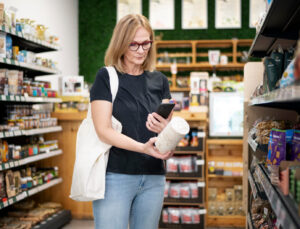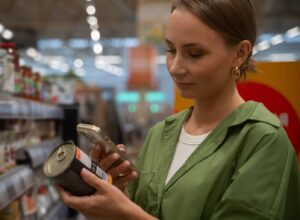Much of our daily life is now digital. Yet, in some areas, we still find ourselves doing things manually for lack of adequate digital alternatives. One of them is the humble shopping list. Writing and maintaining grocery lists is tedious, whether using pen and paper or a notes app.
Here is where retailers can make things easier with a simple feature: Adding a grocery list scanner to their mobile app – all it takes is a mobile Barcode Scanner SDK.
Discover how the shopping list of the future works – and what unexpected advantages it offers retailers.
Scan & Go, product recommendations, and digital grocery lists: the world of mobile retail apps
Retailers all over the world routinely use technology to improve customer loyalty, and the distinctions between in-store and online shopping experiences have never been blurrier. A consumer survey found that U.S. consumers prefer physical stores that also offer an app, website, or other digital service.
Mobile retail apps provide endless ways to foster consumer engagement. Let’s take a look at four features that will take your consumer relationships to the next level: Scan & Go, personalized recommendations, loyalty programs – and digital shopping lists.
Scan & Go
Modern approaches like Scan & Go enable customers to add products to a virtual shopping basket by scanning barcodes and then pay without help from staff. Thanks to the grocery industry’s strong emphasis on brick-and-mortar locations, such retail concepts are growing in popularity, as proven by our customers Coop Estonia and Rimi Baltic.
Personalized recommendations
To keep their lead on the competition, however, retail enterprises have to expand their digital offering further. Shopping apps now commonly enrich the in-store experience by offering recommendations, recipes, and reviews. All of which, eventually, increases sales.
And they are becoming smarter: Walmart, for instance, already introduced GenAI Search, which suggests relevant products based on search prompts by customers.
Loyalty programs & offers
Another way to build customer engagement are loyalty features that let customers earn points, get cashback, and receive personalized offers.
For retailers, loyalty programs can give insight into crucial data such as customer preferences and purchasing behavior.
Digital grocery lists
But what is the basis of every shopping trip? It’s the shopping list, of course! Let’s explore the benefits of having a digital grocery list feature in a mobile retail app.
How does a barcode scanner contribute to a digital shopping list?
There are several advantages to integrating a digital grocery list feature into a retail app – and adding a barcode scanner. Before we dive deeper, though, let’s discover how this works in practice:
- A customer wants to add items to their in-app shopping list.
- They scan the needed product’s barcode with their phone. If they don’t have it at home anymore, they just type in its name.
- They can now set the quantity, check for available grocery coupons, and invite others to add their own items. This is a straightforward way to share grocery lists and edit them no matter where or when.
- Once at the grocery store, the user just checks off the digital grocery list items directly on the device. When using Scan & Go, they are automatically ticked off as they’re scanned.
Smart devices are replacing pen and paper: the four core benefits
This workflow is much more convenient than working through a grocery list with pen and paper. Digital grocery lists are convenient not only to consumers but also to retailers, who can benefit from them in the following ways.
Increasing customer engagement
The secret to boosting customer retention is offering multiple touchpoints that keep shoppers engaged with brands. Digital shopping lists give companies exciting opportunities to connect with shoppers creatively.
One strategy adopted by retailers is to add gamification components to entice users to scan barcodes and save money with special discounts, awards, or customized offers. Users are excited by this gamified experience, inspiring them to use this feature and purchase new goods.
Cross- and upselling
Every store hopes to raise the average basket value of its customers, and integrating a grocery list scanner can encourage that. This feature is a natural place for retailers to add recommendations for related or complementary products.
Consider a scenario where a buyer adds a jar of pasta sauce to their list and is given suggestions for products like pasta, herbs, or grated cheese. Cross-selling and upselling opportunities are virtually limitless. To add further touchpoints, customers can be provided with weekly ads, reminders like “add milk to your weekly grocery list,” and recommendations for new items.
Streamlined shopping experience
Customers usually take a lot of time browsing a retailer’s aisles, carefully evaluating prices, and searching for specific items. Navigating huge grocery stores can turn into a stressful experience rather quickly.
A digital grocery list allows shoppers to evaluate prices before they enter a physical store. Additionally, retailers can enhance such a list with helpful information such as a product’s location. To round out this seamless shopping experience, customers can complete their purchases via Scan & Go.
Insights and analytics
Understanding customer behavior and preferences is essential for retail enterprises aiming to customize their product offering and marketing strategies. Digital shopping lists provide valuable data that enables businesses to understand buying trends, top items, and even the success of marketing efforts. However, collecting users’ behavior data requires their permission, so informing them and asking for approval in the grocery list scanner app is paramount.
This empirical approach allows retailers to make data-supported decisions, enhance product offers, and develop customer-relevant, focused marketing campaigns.
Other benefits of grocery store barcode scanning
For internal uses, barcode scanner software can be integrated into any employee-facing web or mobile application. Like that, mobile barcode scanners replace expensive dedicated devices and enhance the following operations:
- Inventory management: Instead of manual data entry, employees can scan items as they arrive, are shelved, or sold, providing instant updates to inventory records. Stock audits become faster and more accurate, which is particularly important for tracking perishable goods.
- Enhanced mPOS: At the same time, an employee stocking shelves can quickly check out a customer on the spot with the same barcode scanner software in a mobile point-of-sales system.
- Supply chain management: When data is centralized in a database, barcode scanning enables access to a product’s supply chain history. By analyzing this data, retailers can identify bottlenecks that lead to delivery delays, streamlining operations.
Outlook
Innovation is crucial in the ever-evolving retail world, and adding a Barcode Scanner SDK to their mobile retail app can give enterprises a significant competitive advantage.
Retailers must improve the general shopping experience by accelerating the checkout process, finding new touchpoints for cross-selling and upselling, and offering outstanding features that separate them from other stores. A grocery list feature has a lot to offer for retailers and customers both.
Keeping an eye on future trends in retail barcode scanning is crucial. The GS1 Sunrise 2027 initiative aims to replace all 1D barcodes on products with a single 2D barcode – and retailers will have to update their POS technology to accommodate this change by the end of 2027. Though the implementation is not without challenges, this will open up a whole new range of opportunities. However, to stay ahead of the game, retailers must act now.
Choosing the right barcode scanner software is vital for these efforts. The Scanbot Barcode Scanner SDK reliably scans all common 1D and 2D barcodes no matter the conditions. Experience its performance for yourself in our free demo apps – or contact us at sdk@scanbot.io to learn more about our solutions..
FAQ
How does grocery list scanning improve customer engagement and loyalty?
By offering customers a seamless way to create and manage their shopping lists, businesses can integrate loyalty programs, suggest relevant offers, and provide a more personalized shopping experience—all of which encourage repeat purchases.
Can the technology be customized to fit specific business needs?
Yes, grocery list scanning solutions can be tailored to include brand-specific promotions, regional product availability, integration with loyalty programs, and even support for multiple languages.
What are the long-term benefits of implementing grocery list scanning technology for retailers?
By implementing grocery list scanning technology, retailers can increase customer engagement and potentially gather a deeper understanding of consumer preferences.







